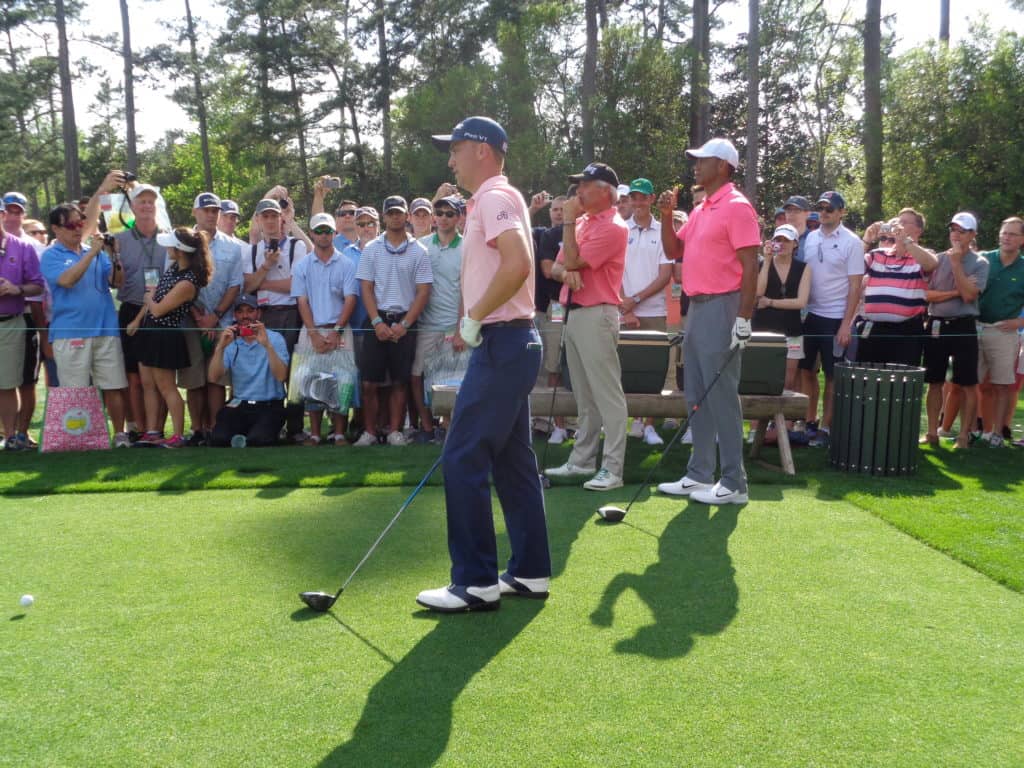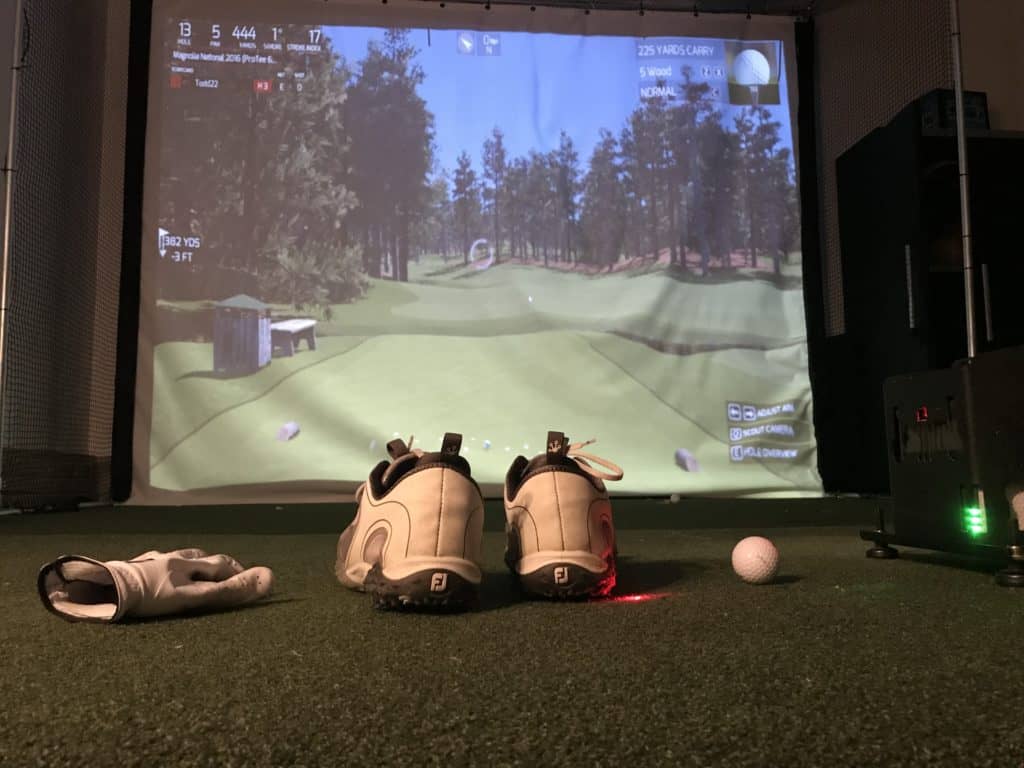Most people that play golf are in constant search for the perfect golf swing or just simply a good golf swing.
They will spend hours at the driving range or on the course trying to find a good swing.
One that will hold up under pressure and bring some consistency to their game and the overall experience.
We believe golf is a journey and part of the joy of that journey is the ongoing challenge to find a swing that will work for you. A swing that you can own and control at the right times. A swing that will help you perform in the clutch, whether that is in a big time tournament or a local round with your friends.
What Is a Good Golf Swing?
A swing that brings about consistency that allows the golfer to have solid contact, control the start line, the curve of the ball and have enough distance to play the course. There are multiple approaches that golfers can take to help them achieve these basics.
Keys to a good golf swing:
- Solid contact
- Control the start line
- Control the curve of the ball
- Have enough distance to play the course
The best golfers are able to step up to a shot, making a solid swing that produces clean contact, the ball starts on the intended line and the curve is predictable. They also have enough distance to play the course and sometimes use their distance to their advantage.
So how does a golfer go about building a good swing?

Key #1: Understand the Basics
- Fundamental #1: The golfer’s ability to control the bottom of the golf swing. The best golfers will hit the ground in the intended spot, close to 100% of the time.
- Fundamental #2: The golfer’s ability to control the curve of the golf ball. The best golfers are able to start the ball to the right or left of the target line and have the ball curve towards the target without the ball over curving past the target.
- Fundamental #3: The golfer’s ability to have enough power to play the golf course. This means they are able to hit the ball far enough to play the course in regulation.
You can reach your full potential with different golf stances, setups and alignments as long as your 3 fundamentals stay strong.
Key #2: Find an Instructor
I would highly recommend finding an instructor that will help get your game to the level you want. Every golfer might have a different definition of what a good golf swing is. Some might just be content with getting the ball in the air or hitting the ball really far.
Top Instructors To Help You Develop A Good Swing
I picked these five above because I believe they are genuine in their approach, have studied and utilized their approach for many years and know it inside and out. They also have a ton of free information and all have a paid option to dive into further. They have complete systems to help you develop “A good swing.”
Option 1: Shawn Clement
Shawn Clement is perfect for the golfer that is tired of chasing positions. Maybe this golfer has spent years trying to hit P1 or P4 or P7 in their swing. They have spent time analyzing video and have not gotten any better. They stand over a golf shot and are slowed down by the amount of swing thoughts or feels running through their head.
Shawn Clement has an impressive communication approach, plenty of amazing youtube videos and an approach that is refreshing. His approach is based on several key thoughts or philosophies that include:
- We are gravity geniuses
- We are bad at hitting positions
- We should give ourselves a task to complete
- Our mind should be focused on a target during the swing
- We can control ball flight through our setup and the direction to start the ball
This approach allows the golfers to determine the shot they want to hit, determine the flight plan, setup to help produce that flight plan, pick a target way off, pick an intermediate target and then get out of the way on the way back and out of the way on the way through.
Clement teaches a swing that encourages a full turn without restriction. Both on the way back and on the way through the shot. I find the approach very refreshing and perfect for many golfers. Too many golfers are so stuck trying to hit certain positions that the fun of the game has been lost and the natural ability to make an athletic motion has been diminished!
Option 2: Mike Malaska
Mike Malaska is the perfect instructor for former baseball players or those that want to learn to train their hand eye to hit certain shots. He too believes in a swing that is more natural and allows the hands and the athletic ability of the golfer to take over. The golfer that is tired of chasing lag, or hitting certain positions on the way down might love the teaching of Mike Malaska.
He is someone that struggled with the game after initially having great success. He fell in the trap of trying to hit certain positions in his swing, one that often got him “stuck” right before impact. He chased these positions and followed these teachings even though now he realizes it wasn’t best for his game.
He has some excellent videos on training the right hand to work and react to the shot that is needed. If you need extra loft then train the right hand, if you want to hit a draw, then train the right hand. His approach is perfect for those that love to practice the game and get joy from making a natural motion that is based on an athletic approach.
Option 3: Stack and Tilt
For those that want a complete system, the Stack and Tilt approach is an extremely complete system. In their instructional videos, they provide every little detail imaginable. They were the first one the scene to promote the weight staying more centered with 60% of the weight starting on the front leg. More and more instructors have now promoted a centered based approach with the shoulders while utilizing the tilt in the shoulders to help the head stay centered and create enough power to play the course.
They major philosophy is based on these three fundamentals of the game:
- Control the bottom of the golf swing. The best golfers can hit the same spot on the ground 99 times out of 100.
- Control the curve of the ball. The best golfers are able to hit their start line and control their curve without it overcuring.
- Have enough distance and power to play the course.
They teach their students to read their ball flight, understand what causes a ball to start right or left or curve too little or too much and then make adjustments in the swing based on these ball flights! This systematic approach is great for the analytical golfer that enjoys a system to reach their full potential.
I find the system to be helpful in making quick fixes and adjustments while on the golf course.
Option 4: George Gankas
The golf instructor that is changing the world of instructors. This hip and in control golf instructor believes in speed in the swing and creating a swing that has plenty of rotation. Think of Matt Wolff as the model Gankas swing from the perspective of hit rotation on the backswing and clearing out on the way through. The speed is real when you follow the George Gankas approach.
The golfer who has struggled with speed and stalls through the zone might be interested in the Gankas approach. You have to be willing to put in plenty of time, learn the leg work and dive into the swing approach of Gankas.
He does have a paid membership that is pricey, but the depth of the videos is highly impressive and is at a level I have never seen before and I have purchased many different membership opportunities and instructional videos to grow my own knowledge of the game.
He too believes in a full backswing that is not restricted, certain leg movement that includes a squat and turn and then rotating completely through the shot. If you want some speed and club face stability, Gankas is your instructor!
Option 5: Jim Venetos
Jim Venetos is perfect for the golfer that has tried everything and still slices the ball or can’t make the turn required by other golf instructors. This “stillness” based approach is all based on a preset position, where the golfer sets up with 70% of the weight on the front side and closed down the front shoulder to create a path that is in to out and starting with a somewhat square ball flight. This swing helps produce the draw that some golfers can only dream about.
The golfer that struggles with the slice and has never been able to draw the ball, should highly consider this swing and at least check it out. It looks different, but it produces. The stability with the irons and the consistency of the start line and curve is rather impressive!
You can completely free your mind of swing thoughts and simply focus on staying still. Jim Venetos has a very zen like approach to the game and makes his swing sound amazing. To his credit, he will work with a golfer at great lengths through his membership site.

Key #3: Assess Your Game
There are two different ways to assess your game.
- At the range with tracking data
- On the course by tracking data and score
Option 1: At the range with tracking data
Assess your low point control with this drill:
The Drill: The Low Point Control Dril
- Take some yard paint and patina a 1-2 yard long line.
- Setup with 55% of your weight on your front side.
- Try to hit the target side of the line and see how many times out of 10 you can do this successfully!
- Repeat this drill every day for a month, tracking your progress and your ability to do this successfully in trials of ten.
- You may need to start with half swing and progress to full swings.
If you are struggling, put more weight forward and work on keeping your head still to help control the low point in the swing.
Assess your ability to hit your start line and control your curve with this drill:
Here is a wonderful drill you can use to build a stock shot and assess your progress:
- At the driving range, set up an alignment stick about 6-8 yards in front of you, straight down your target line.
- If you have a second alignment stick, set the stick 3-4 yards right of the first stick (for a draw) or left of the first stick (for a fade).
- Complete your initial assessment and see how many times out of 10 you can start the ball to the right or left of your target. Pick one side and measure your game at this point.
- The goal is to eventually get 7 out of 10 shots to start to the correct side and draw back towards the target.
Here is the dril being explained by Kyle Morris:
Assess your swing speed:
Use the SuperSpeed System to increase swing speed:
Regardless of your current ability level or swing speed, we could all use additional speed.
This speed drill below will also help you improve your swing mechanics. It is worth checking it out regardless of your current ability level. The swing mechanic improvement along with the additional distance will help your game!
Let’s face it, regardless of the current state of your game we all want more speed. It has become very clear the need for speed in the golf swing and there are ways to add speed! The analytics on all levels of golf show how important speed and additional speed are in reducing golf scores.
Once you have identified your swing speed, get to work and train every other day for best results!
It is time to start training for some additional speed. This is a drill and training protocol that I would highly recommend.
SPEED DRILL: Increase your swing speed through overspeed training
- Check out SuperSpeed Overspeed Training Protocols
- Train every other day for 10-15 minutes.
- See a 4-6% increase in swing speed as early as the first training protocol.
The number one thing that has helped me gain significant distance is the SuperSpeed Training System. This overspeed based system where you train every other day for about 10-15 minutes with different swing sticks can help you increase your swing speed by 5-8% which can be 20-30 yards. Who wouldn’t want an extra 20-30 yards. Plus it helps improve your mechanics.
Check current prices on SuperSpeed Training System, here.
The analytics are pretty clear on the importance of speed in the game of golf. Would you rather hit your approach shot from 130 yards of 160 yards? The answer is pretty simple! We know that over the course of time, we will hit shots from 130 yards much closer than from 160 yards, whether we are an average amateur golfer, a scratch golfer, or a PGA Tour member!
The key is having shorter approach shots, so we can hit the ball closer to the hole and then make more putts! Speed is king in the game of golf! Make sure you check out SuperSpeed Golf!
Option 2: On the Course by Tracking Data and Score
When you play your rounds of golf, go ahead and keep track of the following stats:
- Greens in Regulation
- Fariways Hit
- Putts Per Hole
- Scrambline
- Sand Saves
- Average Driving Distance
Track these key stats in groups of 5-10 rounds as your work on the drills above. The three drills above will help you in everything but your short game.
Here is the average percentage or yardage of a scratch golfer. This can serve as a benchmark to measure your progress.
Scratch Golf Average Stats:
| Greens in Regulation | 67% |
| Fairways Hit | 53% |
| Putts Per Hole | 1.67 |
| Scrambling | 54% |
| Sand Saves | 59% |
| Average Driving Distance | 251 |
BONUS OPTION:
If you are serious about improving, I would highly recommend checking out a Skytrak Launch Monitor. This amazing and affordable device can give you some key stats in the following areas after every shot that you hit during practice or in a golf simulator setup:
- Carry and Total Distance
- Ball Speed
- Spin Rate
- Spin Axis
- Launch Angle
Having this information and being able to practice 365 days a year is essential to getting better and improving your game.
Here are my top three recommended affordable launch monitors. Check out the links below for current pricing:
Final Thoughts: Don’t Forget About The Short Game
While practicing the short game might be overly appealing as hitting balls at the range, the fastest way to lower scores is by becoming a better short game player. This includes hitting quality chip shots and being able to make putts in the 3-10 foot range and avoiding 3 putts, especially outside of 30 feet.
If you start hitting more and more chip shots inside of 10 feet and start making putts, the pars will add up quickly and you will be on your way to shooting lower scores.
Here are some short game resources for you:

Take Action – What You Can Do Today to Get Better
What does this mean for you? I believe in the following recipe to get better:
1 – Improve your motion in the golf swing by identifying a golf instructor. Here are some options:
Here is a list of golf instructors that we have reviewed:
2 – Train to swing faster and improve your swing speed. Here are some options:
Looking to gain more Speed and Distance in your swing. Two Options:
3 – Understand course strategy and work to break through your next barrier. Here is a series on breaking through:
We have provided guides on how to break 100, 90, 80 and 70. Check out more below, if interested.
4 – Practice Frequently
Did you know that I build a golf simulator in my garage and have played over 500 rounds of golf on my SkyTrak system? It has been a game changer and one worth checking out. Here are some of my other posts on golf simulators frequently asked questions:
- Is a Golf Simulator Worth It?
- How to Build a Golf Simulator?
- What is the Best Golf Simulator?
- Golf Simulator Accessories?
- How to Build a Golf Simulator for under $7000
- Top 11 Reasons to Buy a SkyTrak
- How to Build a Golf Simulator for Under $1000
- Why Build A Golf Simulator?
- What Space is Needed?
- Can A Golf Simulator Improve My Game?
- How Much Does A Golf Simulator Cost?
- Don’t Forget to Check out our 15 best golf swings of all time.
I am an amateur golfer on a journey to get better, enjoy the game as often as possible and share my passion and knowledge with others. I have coached high school golfers at a high level and have a great passion for the game and want to give back. I enjoy learning about the golf swing and am currently studying to be a certified professional golf instructor. Join me in our journey to get better everyday.

